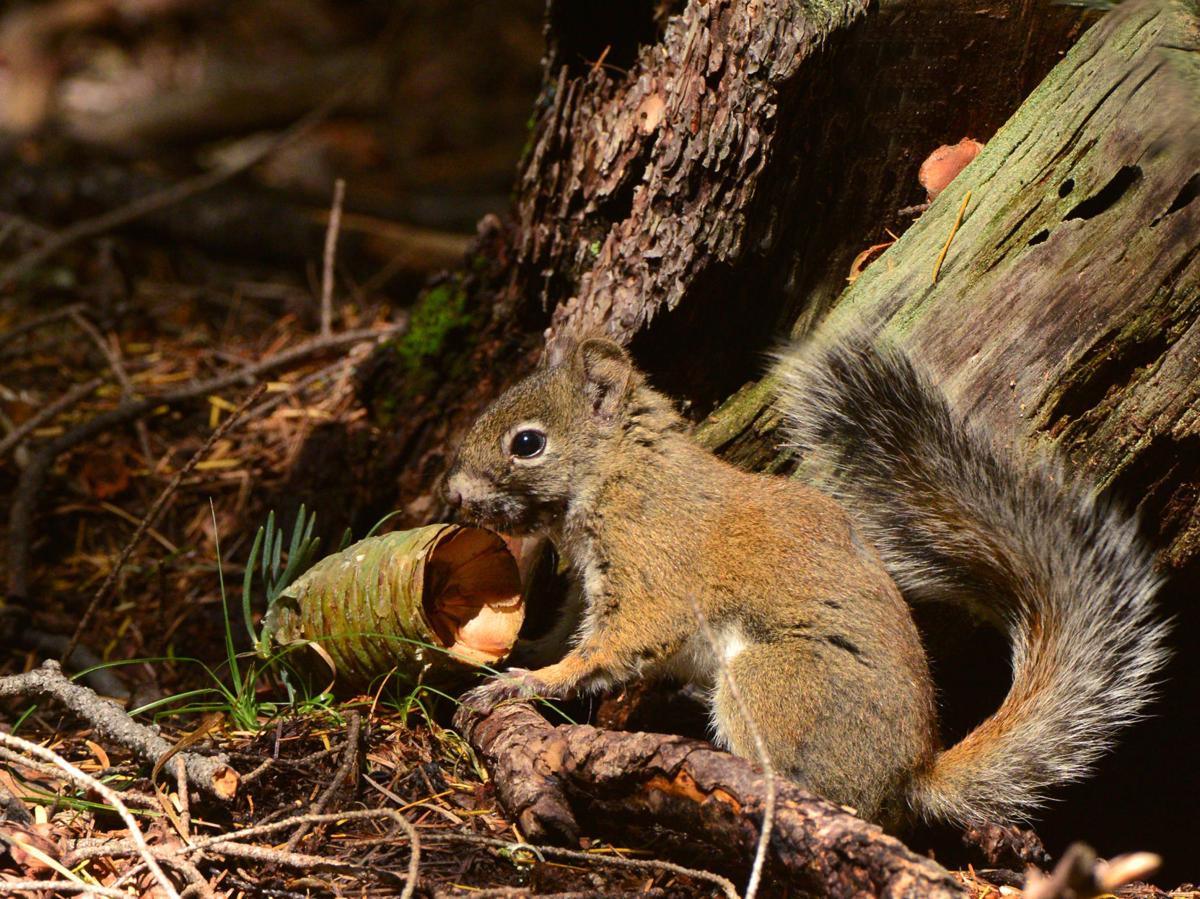A top U.S. Fish and Wildlife Service official said Wednesday that he’s “not optimistic” about the endangered Mount Graham red squirrel’s ability to survive in the wild after a new survey estimated its numbers have fallen to 35.
The annual survey estimated the squirrel population has dropped from a 2016 estimate of 252 squirrels because of the impacts of this summer’s Frye Fire. The lightning-caused blaze burned 48,000 acres on the mountain near Safford in Southeastern Arizona.
The only other known remaining Mount Graham red squirrels — a subspecies of a larger red squirrel species — are five specimens living in captivity at the Phoenix Zoo, wildlife service officials said Wednesday. Three are males and two are females.
Extirpation of the squirrels in the wild is possible this winter because of the harsh climate on the mountain that rises to about 10,720 feet, said Steve Spangle, Arizona field supervisor for the wildlife service. At the same time, the service and other agencies are reviewing a host of possible measures to help the species survive in its reduced habitat, he and other authorities said.
“We’re very worried about a critter going extinct under our watch,” Spangle said. “It doesn’t mean we won’t do what we can.
“It’s a very harsh winter climate where they occur. They rely on stashes of cones and middens to get through winter. Most of the middens burned up. They’re made up of dried up woody material. They will not survive even a relatively cool ground fire,” he said. “We’re not optimistic at all.”
The annual squirrel census, conducted in mid-September, found evidence of fire activity in 95 percent of the surveyed locations. Eighty percent of those locations showed at least some habitat loss.
Forty-four percent of the surveyed areas were completely burned, according to the survey conducted by the wildlife service, the Arizona Game and Fish Department, Coronado National Forest, the Arizona Center for Nature Conservation working with the Phoenix Zoo, and the University of Arizona.
The 48,000-acre fire was ignited June 7 in an old burn scar remaining from the 2004 Nuttall Fire on the mountain. It burned in steep, rugged terrain on Mount Graham’s slopes before it was fully contained by the end of July.
But wildlife service official Jeff Humphrey and Arizona Game and Fish official Tim Snow said it’s possible this survey missed some squirrels who dispersed into peripheral habitat — outside the area usually surveyed — because of the fire.
Squirrels aren’t actually counted in the census, they noted. Squirrel middens, areas of vegetation where squirrels store their cones and other food resources for the winter, are surveyed as surrogates for the squirrels, they said. Evidence of activity at the middens is used to estimate their population size, said Snow, a Game and Fish wildlife specialist.
“This year, the forest has experienced a particularly challenging fire season, with 79 fires burning over 125,000 acres,” said Coronado National Forest Supervisor Kerwin Dewberry in the wildlife service’s news release Wednesday. “Several fires covered large portions of the mountain ranges we manage, including the Frye Fire.”
Potential impacts of climate change are of concern in this matter, particularly for species such as the squirrels who are isolated on a mountaintop, Humphrey said. Over time, the fire season continues to get longer and longer, he said.
“As the climate changes, it stands to reason that the band of available habitat, over time, rises up the mountain. As the mountain becomes narrower, the available habitat becomes smaller,” Humphrey said.
The Mount Graham red squirrel is one of 25 subspecies of the red squirrel known to exist in North America. It was listed as endangered in 1987. Mount Graham red squirrels live only in upper elevation conifer forests of the Pinaleño Mountains and feed primarily on conifer seeds. This subspecies is highly territorial and has lower reproductive rates than red squirrels in other locations.
A number of measures are under consideration to try to stabilize or upgrade red squirrel populations on the mountain, Humphrey said.
Funding is being sought for addressing impacts to red squirrels from competition by the non-native Abert’s squirrel, for creating artificial middens and putting some cones in them to provide food through the wintertime, he said. Supplemental feeding beyond cones is also possible, said Spangle, including the use of high-energy food such as grains and nuts.
The most immediate priority is to capture aerial imagery of the remaining habitat, Spangle said. That could help determine what forest structure is compatible with squirrels and where to put artificial middens and to conduct supplemental feeding and possibly even relocate some of the remaining squirrels, he said.
Capturing those three-dimensional images using low-flying aircraft with specialty equipment could cost an estimated $105,000, he added.
In the longer term, the best measures would be to remove existing development on the mountaintop area to free up more squirrel habitat, said Robin Silver, an environmental activist who has been fighting authorities for decades over squirrel protection.
Silver, conservation chair for the Tucson-based Center for Biological Diversity, said the federal government should follow the advice of a 1990s-era recovery plan for the Mount Graham red squirrel that suggested removing some existing cabins and an Arizona Church of Christ Bible camp along with some roads from the area.
He also advocated removal of the University of Arizona’s three telescopes on the mountain — telescopes whose construction he had bitterly and unsuccessfully opposed.
“Everyone will agree now we need to recover the habitat,” Silver said. “This is a habitat issue.”
Spangle said his understanding is that the area around the telescopes is no longer squirrel habitat because it’s been burned.
Long-term habitat recovery is something authorities will address later, “if we can keep them going in the shorter term,” Spangle said of the squirrels.
“Right now,” he said, “we’re concentrating on getting them through the coming winter.”





